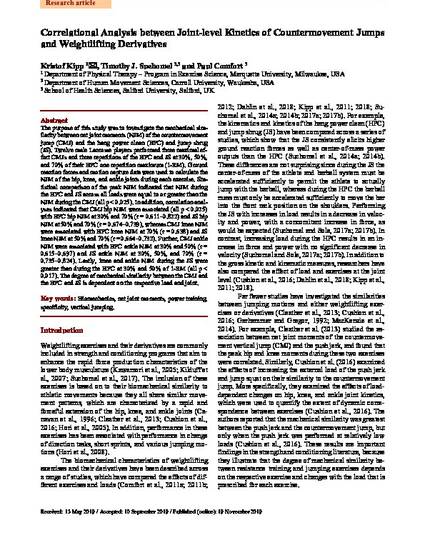
The purpose of this study was to investigate the mechanical similarity between net joint moments (NJM) of the countermovement jump (CMJ) and the hang power clean (HPC) and jump shrug (JS). Twelve male Lacrosse players performed three maximal effort CMJs and three repetitions of the HPC and JS at 30%, 50%, and 70% of their HPC one repetition maximum (1-RM). Ground reaction forces and motion capture data were used to calculate the NJM of the hip, knee, and ankle joints during each exercise. Statistical comparison of the peak NJM indicated that NJM during the HPC and JS across all loads were equal to or greater than the NJM during the CMJ (all p < 0.025). In addition, correlation analyses indicated that CMJ hip NJM were associated (all p < 0.025) with HPC hip NJM at 30% and 70% (r = 0.611–0.822) and JS hip NJM at 50% and 70% (r = 0.674–0.739), whereas CMJ knee NJM were associated with HPC knee NJM at 70% (r = 0.638) and JS knee NJM at 50% and 70% (r = 0.664–0.732). Further, CMJ ankle NJM were associated with HPC ankle NJM at 30% and 50% (r = 0.615–0.697) and JS ankle NJM at 30%, 50%, and 70% (r = 0.735–0.824). Lastly, knee and ankle NJM during the JS were greater than during the HPC at 30% and 50% of 1-RM (all p < 0.017). The degree of mechanical similarity between the CMJ and the HPC and JS is dependent on the respective load and joint.The purpose of this study was to investigate the mechanical similarity between net joint moments (NJM) of the countermovement jump (CMJ) and the hang power clean (HPC) and jump shrug (JS). Twelve male Lacrosse players performed three maximal effort CMJs and three repetitions of the HPC and JS at 30%, 50%, and 70% of their HPC one repetition maximum (1-RM). Ground reaction forces and motion capture data were used to calculate the NJM of the hip, knee, and ankle joints during each exercise. Statistical comparison of the peak NJM indicated that NJM during the HPC and JS across all loads were equal to or greater than the NJM during the CMJ (all p < 0.025). In addition, correlation analyses indicated that CMJ hip NJM were associated (all p < 0.025) with HPC hip NJM at 30% and 70% (r = 0.611–0.822) and JS hip NJM at 50% and 70% (r = 0.674–0.739), whereas CMJ knee NJM were associated with HPC knee NJM at 70% (r = 0.638) and JS knee NJM at 50% and 70% (r = 0.664–0.732). Further, CMJ ankle NJM were associated with HPC ankle NJM at 30% and 50% (r = 0.615–0.697) and JS ankle NJM at 30%, 50%, and 70% (r = 0.735–0.824). Lastly, knee and ankle NJM during the JS were greater than during the HPC at 30% and 50% of 1-RM (all p < 0.017). The degree of mechanical similarity between the CMJ and the HPC and JS is dependent on the respective load and joint.
Available at: http://works.bepress.com/kristof-kipp/12/
Published version. Journal of Sports Science and Medicine, Vol. 18, No. 4 (2019): 663-668. PubMed Central. © 2019 Journal of Sports Science and Medicine. Used with permission.